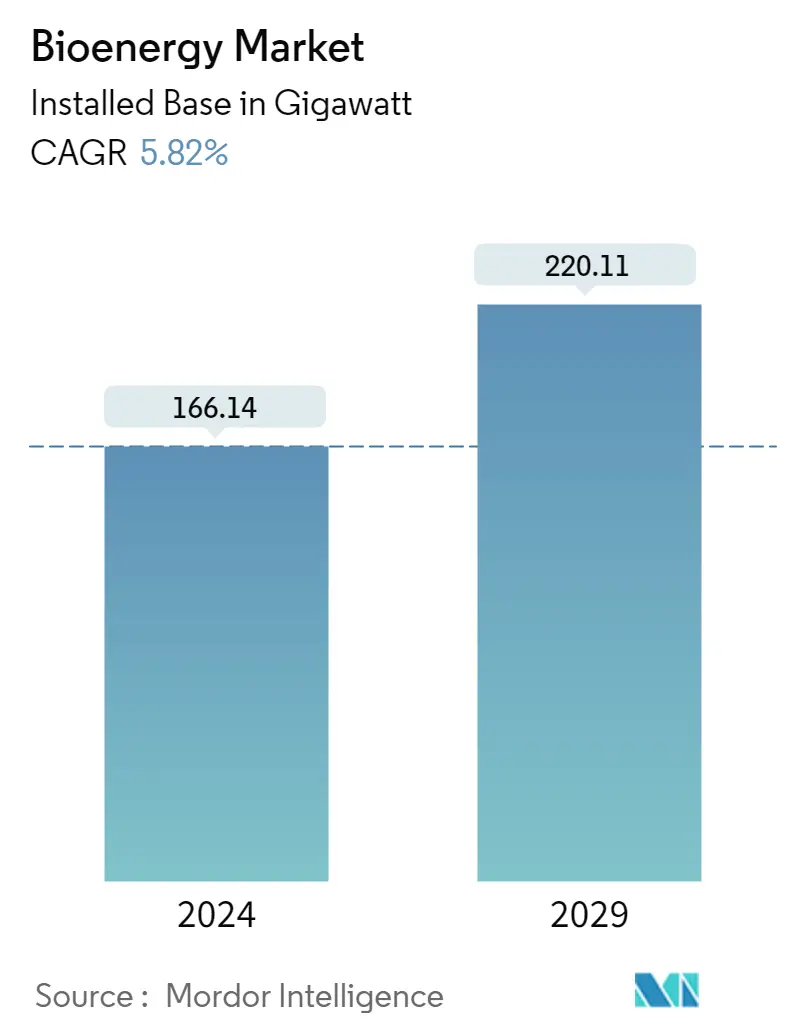Market Size of Bioenergy Industry

| Study Period | 2020 - 2029 |
| Base Year For Estimation | 2023 |
| CAGR (2024 - 2029) | 5.82 % |
| Fastest Growing Market | Asia Pacific |
| Largest Market | Europe |
| Market Concentration | Medium |
Major Players*Disclaimer: Major Players sorted in no particular order |
Bioenergy Market Analysis
The Bioenergy Market size in terms of installed base is expected to grow from 166.14 gigawatt in 2024 to 220.11 gigawatt by 2029, at a CAGR of 5.82% during the forecast period (2024-2029).
- Over the medium term, factors such as increasing investments in bioenergy, and declining electricity generation costs from bioenergy facilities are expected to drive the market during the forecast period.
- On the other hand, the high initial investment for establishing plants may resist market growth. The plant output must be sufficient and consistent to cover the installation and operating costs.
- Nevertheless, Emerging waste-to-energy technologies, such as Dendro Liquid Energy (DLE), a recent German innovation in the biological treatment of waste, present high potential in the bioenergy field, being close to 'zero-waste' technology.
- Europe is expected to dominate the world's market, with most of the demand coming from countries such as Norway, Germany, and the United Kingdom.
Bioenergy Industry Segmentation
Bioenergy is a source of energy from the organic material that drives up plants, known as biomass. Biomass contains carbon absorbed by plants through photosynthesis. It is a form of renewable energy derived from recently living organic materials known as biomass, which can be utilized to deliver transportation fuels, heat, electricity, and products.
The bioenergy market is segmented by type, application, and geography. By type, the market is segmented as Biodiesel, Bioethanol, and Biogas. By application, the market is segmented as Power Generation, District Heating, Transportation, Industrial Applications, and other applications. The report also covers the market size and forecasts across major regions. For each segment, the market size and forecasts have been done based on installed capacity.
| Type | |
| Solid Biomass | |
| Biogas | |
| Renewable Waste | |
| Other Types |
| Technology | |
| Gasification | |
| Fast Pyrolysis | |
| Fermentation | |
| Other Technologies |
| Geography (Regional Market Analysis {Market Size and Demand Forecast till 2028 (for regions only)}) | |||||||
| |||||||
| |||||||
| |||||||
| |||||||
|
Bioenergy Market Size Summary
The bioenergy market is poised for significant growth over the coming years, driven by increasing investments and declining electricity generation costs from bioenergy facilities. Despite the challenge of high initial investment costs for establishing plants, emerging technologies like Dendro Liquid Energy offer promising advancements in waste-to-energy solutions. Europe is expected to lead the global market, with substantial demand from countries such as Norway, Germany, and the United Kingdom. Bioenergy, derived from organic materials, is a crucial component of the renewable energy landscape, accounting for a significant portion of the global energy supply. The sector's expansion is supported by diverse biomass feedstocks, including wood fuel, agricultural residues, and municipal waste, which are integral to meeting renewable energy targets.
The bioenergy sector's growth is further bolstered by strategic initiatives and policy revisions in various countries. For instance, India's revised biomass co-firing policy aims to enhance biomass adoption by reducing import dependencies. Similarly, Spain's plans to double biogas and green hydrogen production targets reflect a broader commitment to renewable energy. Germany's ongoing expansion of bioenergy capacity, alongside projects in Italy and Malawi, underscores the region's dominance in the sector. The market remains semi-fragmented, with key players like Mitsubishi Heavy Industries and Orsted AS driving innovation and capacity expansion. As countries strive for carbon neutrality, bioenergy is expected to play a pivotal role in achieving these environmental goals.
Bioenergy Market Size - Table of Contents
-
1. MARKET OVERVIEW
-
1.1 Introduction
-
1.2 Bioenergy Installed Capacity Historic and Forecast, till 2028
-
1.3 Recent Trends and Developments
-
1.4 Government Policies and Regulations
-
1.5 Market Dynamics
-
1.5.1 Drivers
-
1.5.1.1 Shift towards Renewable Energy
-
1.5.1.2 Less Electricity Generation Cost from Bioenergy
-
-
1.5.2 Restraints
-
1.5.2.1 High Initial Investments
-
-
-
1.6 Supply Chain Analysis
-
1.7 Porter's Five Forces Analysis
-
1.7.1 Bargaining Power of Suppliers
-
1.7.2 Bargaining Power of Consumers
-
1.7.3 Threat of New Entrants
-
1.7.4 Threat of Substitute Products and Services
-
1.7.5 Intensity of Competitive Rivalry
-
-
-
2. MARKET SEGMENTATION
-
2.1 Type
-
2.1.1 Solid Biomass
-
2.1.2 Biogas
-
2.1.3 Renewable Waste
-
2.1.4 Other Types
-
-
2.2 Technology
-
2.2.1 Gasification
-
2.2.2 Fast Pyrolysis
-
2.2.3 Fermentation
-
2.2.4 Other Technologies
-
-
2.3 Geography (Regional Market Analysis {Market Size and Demand Forecast till 2028 (for regions only)})
-
2.3.1 North America
-
2.3.1.1 United States
-
2.3.1.2 Canada
-
2.3.1.3 Rest of North America
-
-
2.3.2 Europe
-
2.3.2.1 Germany
-
2.3.2.2 France
-
2.3.2.3 United Kingdom
-
2.3.2.4 Italy
-
2.3.2.5 Rest of Europe
-
-
2.3.3 Asia-Pacific
-
2.3.3.1 China
-
2.3.3.2 India
-
2.3.3.3 Japan
-
2.3.3.4 Australia
-
2.3.3.5 Rest of Asia Pacific
-
-
2.3.4 South America
-
2.3.4.1 Brazil
-
2.3.4.2 Argentina
-
2.3.4.3 Chile
-
2.3.4.4 Rest of South America
-
-
2.3.5 Middle-East and Africa
-
2.3.5.1 Saudi Arabia
-
2.3.5.2 United Arab Emirates
-
2.3.5.3 South Africa
-
2.3.5.4 Qatar
-
-
-
Bioenergy Market Size FAQs
How big is the Bioenergy Market?
The Bioenergy Market size is expected to reach 166.14 gigawatt in 2024 and grow at a CAGR of 5.82% to reach 220.11 gigawatt by 2029.
What is the current Bioenergy Market size?
In 2024, the Bioenergy Market size is expected to reach 166.14 gigawatt.

